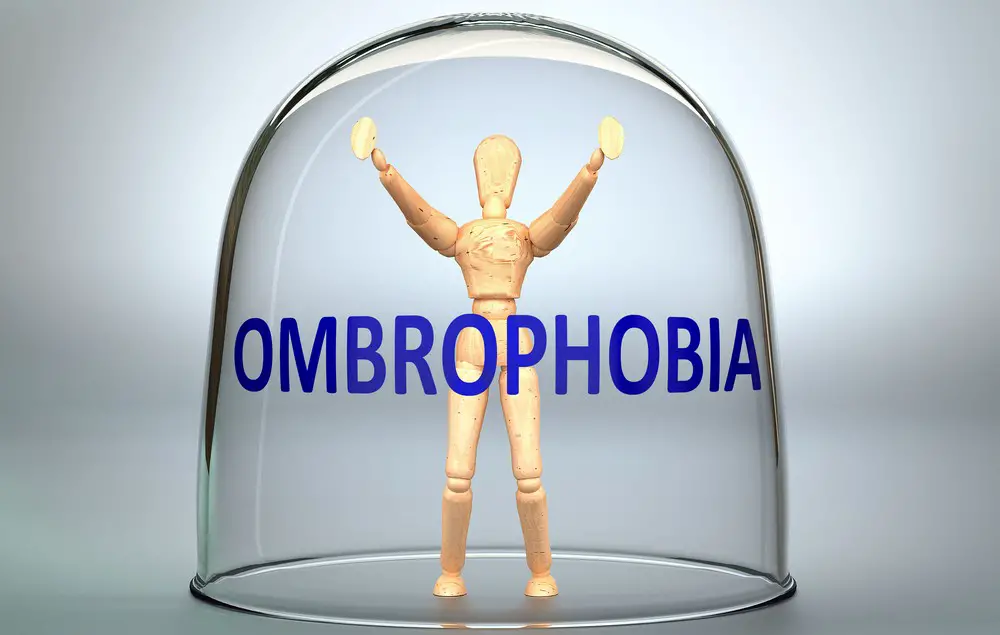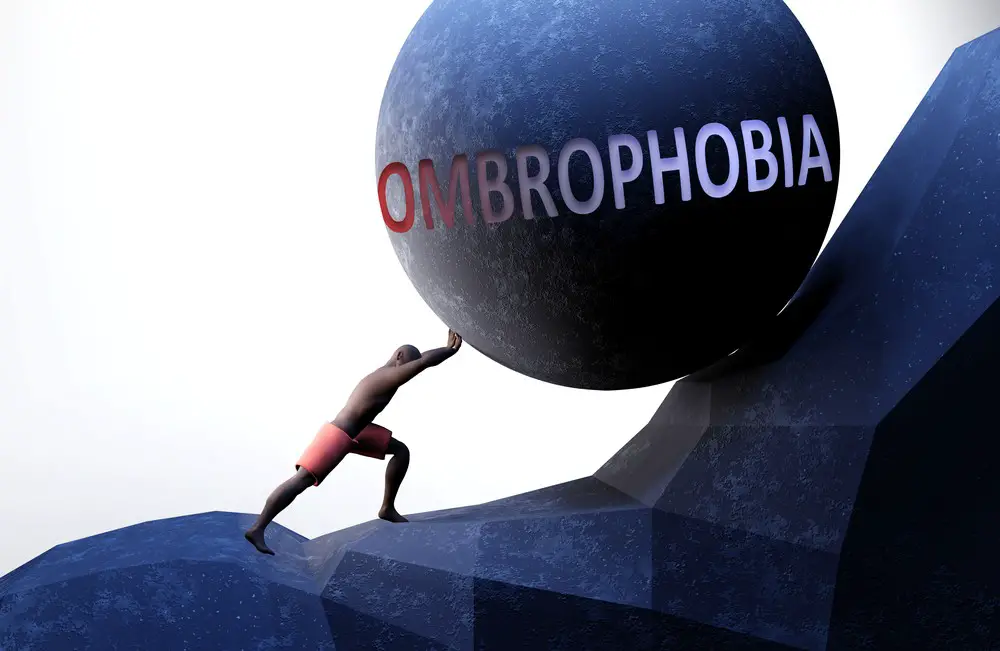As a BetterHelp affiliate, we receive compensation from BetterHelp if you purchase products or services through the links provided
Ombrophobia, the fear of rain, is a specific phobia that affects people differently. This anxiety disorder, although less common than other phobias, can significantly impact an individual’s daily life and mental well-being. The cause of ombrophobia varies for each person; it may stem from a traumatic event involving rain, a general fear of water, or an association with other weather-related anxieties.
The symptoms of ombrophobia can range from mild discomfort or avoidance behaviors to intense panic attacks triggered by the sound or sight of rain. Understanding the factors contributing to this fear and the various treatment options available for those who wish to overcome their ombrophobia is essential. By doing so, individuals can take the necessary steps to regain control of their lives and achieve a healthier mental state.
Understanding Ombrophobia
Definition
Ombrophobia is the intense and persistent fear of rain, impacting an individual’s ability to engage in daily activities and live a normal life. It is a phobia characterized by irrational thoughts and emotions related to rainfall. Those suffering from ombrophobia may experience the following:
- Anxiety or panic attacks when it rains
- Avoidance of outdoor activities during rainy weather
- Excessive checking of weather forecasts
- Distress or disruption in relationships, work, or other aspects of life

Origin
The term ombrophobia stems from the Greek word “ombros,” which means rain, and “phobos,” meaning fear. As with many other phobias, experts believe that multiple factors contribute to the development of ombrophobia, including:
- Traumatic experiences: Past events involving rain, such as accidents, natural disasters, or personal loss, may lead to the formation of ombrophobia.
- Learned behavior: People may develop ombrophobia through observational learning or witnessing the fear of rain in others, particularly during childhood.
- Genetics and biology: A genetic predisposition to phobias, brain chemistry, and temperament may increase the likelihood of developing ombrophobia.
It is important to recognize that ombrophobia, like other phobias, can be treated with professional help, such as therapy and medication, so individuals affected can live healthy, fulfilling lives.
Causes and Risk Factors
Traumatic Experiences
Traumatic experiences are a common cause of ombrophobia. People who have experienced a natural disaster, such as a flood, hurricane, or other storm-related events, may develop this phobia due to their negative experiences. It can also be triggered by a car accident during heavy rain, being stranded in a storm, or experiencing a near-drowning situation in the water created by heavy rainfall.
Genetics
Genetics may play a role in the development of ombrophobia, as it can be passed down through families. Studies have shown that genetics can influence a person’s likelihood of developing a phobia, including the fear of rain. If a close family member suffers from ombrophobia, there is a greater chance that someone within the family will also develop this condition.
Environmental Factors
Environmental factors can contribute to the development of ombrophobia. Living in an area prone to frequent storms and heavy rainfall may increase a person’s risk of developing a fear of rain. Furthermore, those who have never experienced heavy rainfall may also develop a fear of rain due to cultural factors or misconceptions about the dangers posed by rainstorms.
In conclusion, the causes of ombrophobia can be multifactorial and may include traumatic experiences, genetics, and environmental factors. Although each case is unique, understanding these risk factors can help comprehend and address the phobia effectively.
Symptoms and Signs
Physical Reactions
Individuals experiencing ombrophobia may undergo various physical reactions when confronted with rain or the thought of it. Trembling and shaking are common indicators, as well as muscle tension. Nausea and dizziness also occur frequently, with some sufferers even experiencing vomiting. Shortness of breath and rapid breathing can be observed, often due to increased anxiety or fear. Additionally, excessive sweating and feeling numb might be reported by those with ombrophobia.
Behavioral Patterns
Apart from physical reactions, ombrophobia can lead to specific behavioral patterns. Many individuals become socially withdrawn as they try to avoid situations where they may be exposed to rain. This avoidance strategy can interfere with their daily lives and isolate them. Furthermore, ombrophobics may feel depressed due to the restrictive nature of their fear and its impact on their social interactions and personal well-being.

Related Phobias
Astraphobia
Astraphobia is the fear of thunder and lightning. People with this phobia may experience anxiety, panic attacks, or heart palpitations during a storm. They might even prefer to stay indoors during storms to avoid exposure to the elements. Some possible coping mechanisms for astraphobia include therapy, exposure therapy, and distraction techniques such as listening to music or watching TV during storms.
Aquaphobia
Aquaphobia is the fear of water, particularly large bodies like oceans, lakes, or pools. Those afflicted with this phobia may avoid swimming, boating, or any other water-related activities. Treatment options for aquaphobia could involve gradual exposure to water, participation in safe water-related activities, and therapy to address the root causes of the fear.
Antlophobia
Antlophobia is the fear of floods. People experiencing this phobia may live in constant worry of floods or natural disasters, even in areas where flooding is infrequent. Coping options may range from finding a support group to share concerns, seeking therapy to understand and address the underlying fears, and taking proactive measures to prepare for floods.
Homichlophobia
Homichlophobia is the fear of fog. Individuals with this phobia may find it difficult to drive or navigate in foggy conditions, resulting in feelings of anxiety, disorientation, or panic. To manage homichlophobia, therapies like cognitive-behavioral therapy, relaxation techniques, or gradual exposure to foggy environments can help.
Chionophobia
Chionophobia is the fear of snow, especially when accompanied by severe weather conditions. People with chionophobia may avoid participating in winter activities or venturing during snowstorms. Treatment approaches for chionophobia may include exposure to snow in controlled settings, therapy to address the root causes of the fear, or relaxation techniques to manage anxiety.
Nephophobia
Nephophobia is the fear of clouds, particularly dark or stormy ones. This phobia can result in avoidance of outdoor activities on cloudy days or constantly checking weather forecasts. Therapeutic interventions for nephophobia may involve exposure therapy, cognitive restructuring, and relaxation techniques.
Impact on Daily Life
Ombrophobia, the fear of rain, can significantly impact an individual’s daily life. This section will discuss how ombrophobia affects a person’s behavior and activities, focusing on avoidance behaviors.
Avoidance Behaviors
People with ombrophobia often engage in avoidance behaviors to cope with their fear. Some common examples of these behaviors include:
- Weather forecasts: Individuals with ombrophobia may obsessively check the weather forecast to ensure they are prepared for possible rain. This behavior can be time-consuming and can cause anxiety when rain is predicted.
- Asking questions: Those with ombrophobia might constantly ask others about the weather, even if they have already checked the forecast. This can lead to social awkwardness and annoyance for others.
- Refusing to go outdoors: When rain is present or even when there is just a chance of rain, individuals with ombrophobia may refuse to go outdoors. This can limit their activities and impact their social life, career, and overall well-being.
- Hiding: During a rainstorm, a person with ombrophobia may seek shelter in a closed space, such as a closet or under a bed, to escape the rain. This behavior can cause emotional distress and negatively impact their mental health.
Ombrophobia can significantly impact a person’s daily life, particularly regarding avoidance behaviors. Rain avoidance can lead to missed opportunities, strained relationships, and mental health challenges for those affected by this phobia.
Diagnosis and Treatment
Diagnosis of Ombrophobia
Ombrophobia is an anxiety disorder characterized by an irrational fear of rain. It is categorized under specific phobias in mental health. People with this phobia experience excessive panic and anxiety when they encounter rain or even the anticipation of rain. Diagnosis is typically made in a mental health clinic or by a professional therapist who may assess the presence of panic attacks, duration, and intensity of the fear, as well as its impact on the individual’s daily life.
Therapy Options
Various treatment options are available for those diagnosed with ombrophobia. Some commonly used therapies include:
- Cognitive Behavioral Therapy (CBT): focuses on identifying and changing irrational thought patterns related to the fear of rain. It helps the individual to develop healthier and more balanced cognitive processes during rain-related situations.
- Exposure Therapy: In this therapy, a person is gradually exposed to their fear of rain in a controlled environment. Over time, the person becomes desensitized and more comfortable in the presence of rain.
- Hypnotherapy: This can help an individual to change subconscious beliefs and patterns related to their phobia, allowing them to remain calmer and more relaxed during rainstorms.
- Group Therapy: People with ombrophobia may find it helpful to participate in group therapy with others who share the same phobia. This can provide valuable support and understanding from peers.
- Acceptance and Commitment Therapy (ACT): ACT helps individuals to recognize and accept their fear, while focusing on living a meaningful life in spite of the phobia.
Pharmacological Interventions
In some cases, medications can be prescribed by a mental health professional to help alleviate the symptoms of ombrophobia. Some possible pharmacological interventions include:
- Anti-Anxiety Medications: These can provide short-term relief from symptoms of panic attacks, allowing the individual to manage their anxiety more effectively.
- Antidepressants: In some cases, certain antidepressants may also be prescribed to help address anxiety and panic symptoms related to ombrophobia.
It is essential to consult with a mental health professional to discuss the most appropriate treatment options for a specific individual’s needs. Each person may respond differently to various interventions, and finding the right combination of therapies and medications can lead to a more successful outcome in managing ombrophobia.
FAQs
Ombrophobia, also known as pluviophobia, is the irrational fear of rain. While many people might not enjoy wet weather, those with ombrophobia experience intense anxiety or even panic attacks when faced with rain. This section will address some frequently asked questions about the condition.
What causes ombrophobia?
The exact cause of ombrophobia can vary from person to person. Some individuals may have experienced a traumatic event related to rain, such as a natural disaster, an accident, or even an embarrassing moment. Others might develop ombrophobia due to a genetic predisposition to anxiety disorders or through learned behavior from a family member who also has a fear of rain.
How is ombrophobia diagnosed?
A mental health professional, such as a psychologist or psychiatrist, typically diagnoses ombrophobia based on the individual’s symptoms, personal history, and behavior. They will also rule out any underlying medical conditions that could be contributing to the fear.
What are the common symptoms of ombrophobia?
Common symptoms of ombrophobia include:
- Intense anxiety or fear when thinking about or experiencing rain
- Physical symptoms, such as rapid heartbeat, shortness of breath, trembling, sweating, or nausea
- Avoiding outdoor activities or events if rain is expected
- Refusing to leave the house during rainy weather
How can ombrophobia be treated?
Treatment for ombrophobia often involves psychological interventions, such as cognitive-behavior therapy (CBT) or exposure therapy. CBT helps individuals identify and challenge irrational thoughts and beliefs about rain, while exposure therapy gradually exposes the person to rain in a controlled and safe environment to help them overcome their fear. In some cases, medication may also be prescribed to help manage anxiety symptoms.
Can ombrophobia be cured?
While ombrophobia may not always be completely cured, most individuals can experience significant improvement with proper treatment. Early intervention and a commitment to therapy are crucial factors in overcoming ombrophobia and reducing its impact on daily life.
- 3 Ways Wearing a Hat Can Help Lower Your Stress Levels - April 19, 2025
- Breaking the Silence: Why Men’s Mental Health Matters More Than Ever - April 15, 2025
- How to Transform a Home’s Patio Space into a Relaxing Space - March 23, 2025
This site contains affiliate links to products. We will receive a commission for purchases made through these links.



